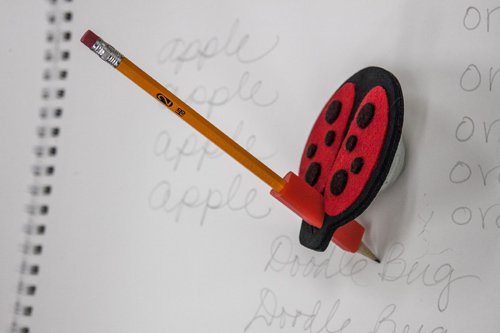CLU wins international design contest
Doodle Bug helps people with disabilities to write

The Doodle Bug was named the “product most likely to become commercially available” at the 2013 Rehabilitation Engineering and Assistive Technology Society of North America Student Design Competition.
Photo: Brian Stethem(THOUSAND OAKS, Calif. – Oct. 23, 2013) California Lutheran University graduate students are on their way to putting their Doodle Bug writing aid into the hands of students with disabilities and adults with arthritis after winning an international design competition.
The Doodle Bug was named the “product most likely to become commercially available” at the 2013 Rehabilitation Engineering and Assistive Technology Society of North America Student Design Competition. The CLU team took home a $5,000 National Institutes of Health project-development grant and a $500 cash prize from the June competition in Bellevue, Wash. The students are now fine-tuning the design, and three of them will spend a week in April receiving marketing and engineering assistance from staff at the Center for the Translation of Rehabilitation Engineering Advances and Technology (TREAT) in New Hampshire.
The CLU team was one of six semifinalists invited to present their products to engineers, clinicians and manufacturers at the competition sponsored by TREAT and the National Science Foundation. The other competitors included students from Chalmers University of Technology in Sweden, Coventry University in the United Kingdom and Loyola Marymount University.
The CLU student-inventors are all teachers who earned credentials to teach the deaf and hard-of-hearing and are pursuing master’s degrees in education of the deaf through a Graduate School of Education program based in Woodland Hills. Led by Jane Hankins of Canoga Park, the team includes Jennifer Black of Granada Hills, Jeannine Blankinship of Carthage, Mo., Roxanne Chandler of Long Beach, Brisi Favela of Oxnard, Jessica Lopez of Yorba Linda, Raven Vilardo of Thousand Oaks and Jeff Westendorf of Thousand Oaks. Hankins, Black and Chandler will travel to New Hampshire during their spring break.
The diverse needs of the students they work with have prompted the graduate students to design creative ways to cope with disabilities beyond hearing issues. They created the Doodle Bug as a way to help a 2-year-old with a severely cleft hand to grasp a pencil or crayon. They didn’t want the toddler to miss out on the language-development skills that come with drawing and forming letters. They used a flat wooden ornament, ball-bearing caster, pencil grip and felt to create a stable, easily manipulated writing system that looks like a ladybug. They quickly realized the device wasn’t limited to helping people with congenital malformations when they gave one to a sixth-grader who had broken her hand and it worked for her. They later discovered it also assists adults with arthritis who can’t hold a pen.
Last year, the same team of students made it to the final round of the competition with a device to prevent walking canes used by people with visual impairments from falling to the floor when they aren’t in use. Since then, they have distributed about 800 of the CLU Clips for free.